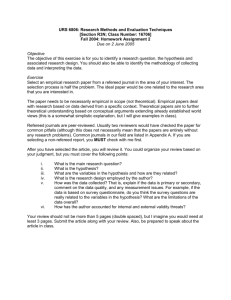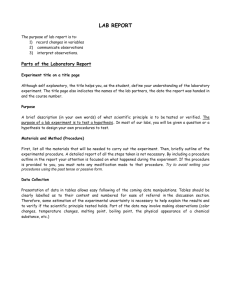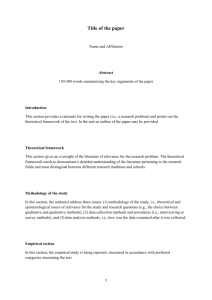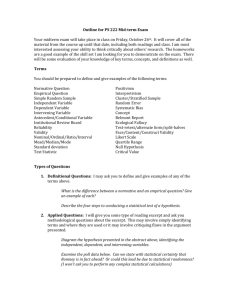Payment Choice and Currency Use: Insights from Two Billion Retail Transactions
advertisement
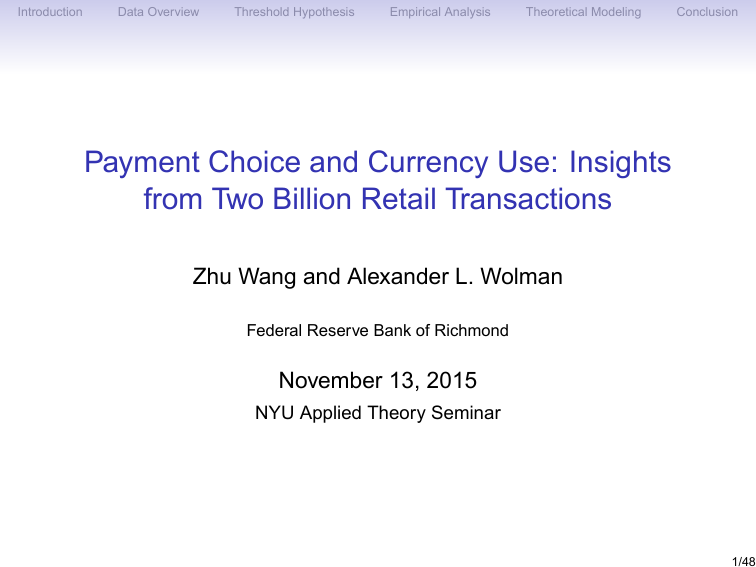
Introduction Data Overview Threshold Hypothesis Empirical Analysis Theoretical Modeling Conclusion Payment Choice and Currency Use: Insights from Two Billion Retail Transactions Zhu Wang and Alexander L. Wolman Federal Reserve Bank of Richmond November 13, 2015 NYU Applied Theory Seminar 1/48 Introduction Data Overview Threshold Hypothesis Empirical Analysis Theoretical Modeling Conclusion Introduction How do consumers choose to pay at the point of sale? Key to understanding transaction demand for money and the evolution of payments system Rich data on non-cash payments from bank surveys Cash? Mainly from small-sample consumer surveys We explore a unique merchant transaction dataset 1 large discount chain, thousands of locations in U.S. 2 billion retail transactions ( millions of consumers) 3 full years, from April 1, 2010 to March 31, 2013 2/48 Introduction Data Overview Threshold Hypothesis Empirical Analysis Theoretical Modeling Conclusion Introduction With this rich dataset we study three themes payment variation across transaction sizes and locations payment variation at weekly and monthly frequencies payment variation over the longer term We connect empirical findings to theories of money demand and payments We show that cross-sectional and time-series payment patterns are consistent with a theoretical framework in which individual consumers choose between cash and non-cash payments based on a threshold transaction size We evaluate factors that may determine the variation of threshold distributions across locations and time 3/48 Introduction Data Overview Threshold Hypothesis Empirical Analysis Theoretical Modeling Conclusion Outline 1. Data overview 2. Threshold hypothesis 3. Empirical analysis Payment variation across payment sizes and locations Payment variation at weekly and monthly frequencies Payment variation over the longer term 4. Theoretical modeling 5. Conclusion 4/48 Introduction Data Overview Threshold Hypothesis Empirical Analysis Theoretical Modeling Conclusion Transactions data Discount retailer, several ’000 stores, dozens of states across most of the U.S. Data covers April 1, 2010 - March 31, 2013. We restrict to cash, debit, credit, check (the four general purpose payment types). More than 1.75 million transactions per day. Median transaction size $7. 5/48 Introduction Data Overview Threshold Hypothesis Empirical Analysis Theoretical Modeling Conclusion Payment variation across time 0.20 0.70 cash, left axis 0.30 0.80 Fraction of Transactions by Payment Type 0.10 0.60 debit, right axis 0.50 check, right axis Apr 2010 Aug 2010 Dec 2010 Apr 2011 Aug 2011 Dec 2011 Apr 2012 Aug 2012 0.00 credit, right axis Dec 2012 6/48 Introduction Data Overview Threshold Hypothesis Empirical Analysis Theoretical Modeling Conclusion Payment variation across locations, March 2013 20 Payment Composition Across Zip Codes Kernel Density for Fraction of Each Payment Type 10 credit 5 debit cash 0 Density 15 check 0.0 0.2 0.4 0.6 0.8 1.0 Fraction of Transactions 7/48 Introduction Data Overview Threshold Hypothesis Empirical Analysis Theoretical Modeling Conclusion Payment variation across transaction sizes: level and dispersion, March 2013 0.4 0.6 0.8 5th Percentile Median 95th Percentile 0.2 0.2 0.4 0.6 0.8 1.0 B. Debit 1.0 A. Cash 0 10 0.0 0.0 5th Percentile Median 95th Percentile 20 30 $ 40 50 0 10 20 30 40 50 $ 8/48 Introduction Data Overview Threshold Hypothesis Empirical Analysis Theoretical Modeling Conclusion Transaction size distribution, March 2013 Transactions concentrated below $15 Kernel Density of Median Transaction Size, Mar. 2013 0.1 0.2 Density 0.06 0.04 0.02 0.0 0.00 Density 0.08 0.3 0.10 0.12 0.4 Kernel Density of Individual Transaction Size, Mar. 2013 0 10 20 30 $ 40 50 0 5 10 15 $ 9/48 Introduction Data Overview Threshold Hypothesis Empirical Analysis Theoretical Modeling Conclusion 0e+00 1e−05 2e−05 3e−05 4e−05 Density Distribution of Median Income Across Zip Codes Our Sample United States 20000 40000 60000 80000 100000 120000 $ Median Income 10/48 Introduction Data Overview Threshold Hypothesis Empirical Analysis Theoretical Modeling Conclusion Theories on money and payments Traditional money demand theories (e.g. Baumol 1952, Tobin 1956, Sidrauski 1967, Lucas 1982) emphasize opportunity cost, especially foregone interest, in households’ decisions of holding cash. Those models consider cash as the only means of payment. Later models (e.g. Prescott 1987, Freeman & Kydland 2000, Lucas & Nicolini 2015) introduce multiple payment means, where consumers choose payment means based on transaction sizes (TS). Others (e.g. Alvarez & Lippi 2009, 2014) focus on the sequential interplay b/w payments and cash balances, allowing multiple payment means but assuming one transaction size (CH). 11/48 Introduction Data Overview Threshold Hypothesis Empirical Analysis Theoretical Modeling Conclusion Threshold hypothesis Following Lucas & Nicolini (2015) and others, we assume that paying with cash incurs a cost proportional to the transaction size z , while paying with other means incurs a fixed cost per transaction. This implies that a shopper has a threshold transaction size z for choosing between cash and non-cash payment means. In location j on date t , there is a distribution of thresholds Gj;t (z ) across shoppers. Each shopper draws a transaction size from a distribution Hj;t (z). We assume that the draws from Gj;t and Hj;t are independent. 12/48 Introduction Data Overview Threshold Hypothesis Empirical Analysis Theoretical Modeling Conclusion Threshold hypothesis In location j on date t , the cash share of size-z transactions Sz; j;t = Pr(z > z) = 1 Gj;t (z) =) @Sz; j;t < 0: @z Accordingly, the cash share of all transactions Sj;t = Z [1 Gj;t (z)]dHj;t (z): We study how cash shares (Sj;t and Sz; j;t ) and the corresponding threshold distributions Gj;t (z ) vary across locations and time. 13/48 Introduction Data Overview Threshold Hypothesis Empirical Analysis Theoretical Modeling Conclusion Explanatory variables Zip-code level variables, fixed across time. Cash holding and payment choice considerations bank concentration (HHI), bank branches per capita robbery rate Adoption of non-cash means of payment median household income, deposits per capita population density Demographic variables: age, sex, race, education, housing status, family status State dummies, fixed across time. Time dummies: day-of-week, day-of-month, month-of-sample. 14/48 Introduction Data Overview Threshold Hypothesis Empirical Analysis Theoretical Modeling Conclusion Empirical model (FMLogit, Mullahy 2010) k Denote sj;t = share of payment type k in zip-code j on date t: Shares sum to one, can be zero or one ) FMLogit: E[sk j x] = Gk (x; ) = exp(x k ) : 4 X exp(x m ) m=1 Normalize Gk k =1;2;3 = cash = 0 for identification: exp(x k ) 3 X 1+ exp(x m=1 ; m) 1 Gcash = 1+ 3 X exp(x : m) m=1 x are zip-code level explanatory variables, state and time dummies. 15/48 Introduction Data Overview Threshold Hypothesis Empirical Analysis Theoretical Modeling Conclusion Estimating overall payment mix Payment shares based on all transactions for a zip-code day, 4.5 million observations (zip-code days). Include median transaction size as an explanatory variable. For continuous x variables, report marginal effects evaluated at the mean. For dummies, report “discrete effects” evaluated at mean. 16/48 Introduction Data Overview Threshold Hypothesis Empirical Analysis Theoretical Modeling Conclusion Findings: zip-code level variables (1) Economic Variables Cash Debit Credit Check -0.018* 0.012* 0.005* 0.001* HHI (bank concentration) 0.030* -0.023* -0.010* 0.003* HHI*metro -0.050* 0.032* 0.024* -0.005* Median transaction size Branches per capita 0.007* -0.005* -0.004* 0.001* Robbery rate -0.054* 0.063* 0.000 -0.010* Median household income -0.033* 0.005* 0.036* -0.008* Deposits per capita -0.006* 0.016* 0.000 -0.010* Population density -0.038* 0.079* 0.091* -0.131* * significant at 1%. Branches per capita = number of bank branches per 100 residents in a zip code. Median household income in $100,000 per household. HHI measured at county or MSA level, transformed to lie between 0 and 1. Deposits per capita in $10,000 deposits per resident in a zip code. Population density is measured in 100,000 residents per square mile in a zip code. Robbery rate = number of robberies per 100 residents in a county. 17/48 Introduction Data Overview Threshold Hypothesis Empirical Analysis Theoretical Modeling Conclusion Findings: zip-code level variables (2) Demographics Cash Debit Credit Check Family households -0.098* 0.089* 0.016* -0.006* Female -0.052* 0.080* -0.005* -0.023* Age share: 15-34 -0.184* 0.163* 0.034* -0.013* 35-54 -0.152* 0.115* 0.053* -0.016* 55-69 0.031* -0.000 -0.013* -0.018* -0.024* -0.038* 0.054* 0.007* 70 * significant at 1%. 18/48 Introduction Data Overview Threshold Hypothesis Empirical Analysis Theoretical Modeling Conclusion Findings: zip-code level variables (3) Demographics Cash Debit Credit Check 0.055* -0.025* -0.020* -0.011* hispanic 0.024* -0.019* 0.003* -0.007* native 0.133* -0.074* -0.052* -0.007* asian -0.018* 0.001 0.032* -0.022* Race: black Educ: high school some college college -0.202* 0.138* 0.057* 0.007* -0.322* 0.233* 0.088* 0.001* -0.225* 0.140* 0.079* 0.007* * significant at 1%. 19/48 Introduction Data Overview Threshold Hypothesis Empirical Analysis Theoretical Modeling Conclusion State fixed effects Top States Bottom States Cash Debit Credit Check NJ AZ MN SD NY ID ND ND MI NV SD MN VT NM OK OK DE FL OH CO FL MD IA NH TX NY AR NY NM ND NV AZ ID SD MS DE AZ MN NJ NJ 20/48 Introduction Data Overview Threshold Hypothesis Empirical Analysis Theoretical Modeling Conclusion Separate models by transaction size The benchmark model provides a useful summary of consumer payment mix across locations and dates. For a given zip code in a given day, the overall payment mix depends on consumer payment choice at each transaction size combined with the transaction size distribution, through consumer characteristics, location & time fixed effects, and median transaction size. To better understand consumer payment choice at each transaction size, we run separate models by transaction size, which take into account individual transaction sizes allow transaction size to affect both coefficients and constants 21/48 Introduction Data Overview Threshold Hypothesis Empirical Analysis Theoretical Modeling Conclusion Description, and summary of findings 22 separate regressions: $1-$2, $2-$3, ..., $14-15, $15-$20, ..., $45-$50, >$50. Similar number of observations to benchmark. Number of underlying transactions between 11 and 199 million. Same explanatory variables but allow their coefficients to differ across size class regressions. The models fit data very well: Marginal effects amplify with transaction size Allowing coefficients to vary across transaction size is important for explaining variation in levels of shares, as well as dispersion 22/48 Data Overview Threshold Hypothesis Empirical Analysis Theoretical Modeling Conclusion Amplification of marginal effects Cash 0.05 Marginal effect Marginal effect 0 -0.05 -0.1 HH Income Deposits Pop Density Robbery -0.15 -0.2 -0.25 0 5 10 15 20 25 30 Value of sale 35 40 45 50 0 0 5 10 15 20 25 30 Value of sale 35 40 45 50 15 20 25 30 Value of sale 35 40 45 50 15 20 25 30 Value of sale 35 40 45 50 0 Marginal effect Marginal effect HHI Rural HHI MSA Branches 0.2 -0.1 -0.2 Family Homeowner Vacant Female -0.3 -0.4 -0.5 0 -0.05 -0.1 0.1 0 5 10 -0.2 Age 15-34 35-54 55-69 70+ -0.4 -0.6 15 20 25 30 Value of sale 35 40 45 -0.8 50 0.4 0 5 10 0 Black Hispanic Native Asian 0.3 0.2 Marginal effect Marginal effect Introduction 0.1 -0.2 -0.4 High School Some College College -0.6 0 0 5 10 15 20 25 30 Value of sale 35 40 45 50 -0.8 0 5 10 23/48 Introduction Data Overview Threshold Hypothesis Empirical Analysis Theoretical Modeling Conclusion Payment variation across transaction sizes and locations (March 2013) B. Debit 1.0 0.4 0.6 0.8 5th Percentile Median 95th Percentile 0.2 0.2 0.4 0.6 0.8 1.0 A. Cash 0 10 0.0 0.0 5th Percentile Median 95th Percentile 20 30 40 50 $ 0 10 20 30 40 50 $ Model does a good job at fitting data It helps to infer the underlying cash threshold distribution Gj;t (z ) It also explains how x affects payment shares by transaction size 24/48 Introduction Data Overview Threshold Hypothesis Empirical Analysis Theoretical Modeling Conclusion Model-implied threshold distribution PMF of Cash Threshold 0.15 1.0 CDF of Cash Threshold Percentiles at $6−$7 50% 95% Percentiles at $6−$7 5% 50% 95% 0.0 0.00 0.2 0.03 0.4 0.06 0.6 0.09 0.8 0.12 5% 0 10 20 30 $ 40 50 0 10 20 30 40 50 $ 25/48 Introduction Data Overview Threshold Hypothesis Empirical Analysis Theoretical Modeling Replace this text with your own abstract. Conclusion Decomposing the level and dispersion 1 A. Cash B. Debit 1.0 1.0 0.8 0.8 0.6 0.6 0.4 0.4 0.2 0.2 5th percentile Median 95th percentile 0.0 0 10 5th percentile Median 95th percentile 0.0 20 30 40 50 0 10 20 30 $ $ C. Credit D. Check 1.0 1.0 “x”-lines variables 5th percentile hold fixed coeffs on zip-code-level 5th percentile Median Median 0.8 0.8 “o”-lines hold fixed all other terms: state/time/constant 95th percentile 40 50 95th percentile 0.6 0.6 0.4 0.4 26/48 Introduction Data Overview Threshold Hypothesis Empirical Analysis Theoretical Modeling Conclusion Explaining the level and dispersion Our model estimates yield empirical counterparts to the cash threshold distributions Gj;t (z ) implied by theory. The level effect: for any location-specific distribution of thresholds, at a higher transaction size there will be a higher fraction of consumers using non-cash payments because their thresholds have been crossed. The dispersion effect: As transaction size increases, consumers in a location with easier access to non-cash options switch increasingly further away from cash compared to locations that do not. Quantitatively, both level and dispersion effects are almost entirely explained by zip-code-level variables! 27/48 Introduction Data Overview Threshold Hypothesis Empirical Analysis Theoretical Modeling Conclusion Payment variation by day of week and month 0.010 Day of Week Marginal Effects 0.000 0.005 ● ● ● ● ● ● ● ● ● ● ● ● ● ● ● ● ● −0.010 ● ● Mon Tues ● ● Weds Thurs Fri cash debit credit check Sat ● Sun 28/48 Introduction Data Overview Threshold Hypothesis Empirical Analysis Theoretical Modeling Conclusion Payment variation by day of week and month 0.04 A. Day of Week solid = cash, dashed = debit ● 0.00 0.02 ● $1 to $2 $10 to $11 $25 to $30 Over $50 ● ● ● ● ● ● ● ● ● ● ● ● ● ● ● ● ● Weds Thurs ● ● ● ● −0.04 −0.02 ● ● ● Mon Tues Fri Sat Sun 29/48 Introduction Data Overview Threshold Hypothesis Empirical Analysis Theoretical Modeling Conclusion Payment variation by day of week and month Day of Month Marginal Effects 0.000 0.005 ● ● ● ● ● ● ● ● ● ● ● ● ● ● ● ● ● ● ● ● ● ● ● ● ● ● ● ● ● ● ● ● ● ● ● ● ● ● ● ● ● ● ● ● ● ● ● ● ● ● ● ● ● ● ● ● ● ● ● ● ● ● ● ● ● ● ● ● −0.010 ● ● ● ● ● ● ● 0 5 cash debit credit check 10 ● ● ● ● ● 15 ● ● ● ● ● 20 ● ● ● ● 25 ● ● ● ● ● 30 30/48 Introduction Data Overview Threshold Hypothesis Empirical Analysis Theoretical Modeling Conclusion Payment variation by day of week and month B. Day of Month 0.02 0.04 0.06 solid = cash, dashed = credit ● ● $1 to $2 $10 to $11 $25 to $30 Over $50 −0.06 −0.02 ● ● ● ● ● ● ● ● ● ● ● ● ● ● ● ● ● ● ● ● ● ● ● ● ● ● ● ● ● ● ● ● ● ● ● ● ● ● ● ● ● ● ● ● ● ● ● ● ● ● ● ● ● ● ● ● ● ● ● ● ● ● ● ● ● ● ● ● ● ● ● ● ● ● ● ● ● ● ● ● ● ● ● ● ● ● ● ● ● ● ● 0 5 10 15 20 25 30 31/48 Introduction Data Overview Threshold Hypothesis Empirical Analysis Theoretical Modeling Conclusion The role of consumers’ financial positions A possible explanation is that consumers’ financial positions vary systematically over the week and the month. If true, we would expect supporting evidence in transaction volumes, e.g., some credit-constrained consumers would drop out of the pool of shoppers as time passes since their last payday. If paydays are correlated across consumers then the cash share would decrease because of systematically lower cash thresholds for the consumers who stay in the pool. 32/48 Introduction Data Overview Threshold Hypothesis Empirical Analysis Theoretical Modeling Conclusion Weekly pattern of transaction volumes A. Day of Week $1 to $2 $10 to $11 1.3 Cash Noncash Total ● ● ● ● ● ● ● Mon Weds Fri Sat ● 0.9 ● 0.9 ● ● 1.1 1.1 1.3 ● Sun Mon Weds $25 to $30 ● ● ● Fri Sat Sun Over $50 ● ● 1.3 1.3 ● 1.1 1.1 ● ● ● ● ● ● ● ● 0.9 0.9 ● ● ● Mon Weds Fri Sat Sun Mon Weds Fri Sat Sun 33/48 Introduction Data Overview Threshold Hypothesis Empirical Analysis Theoretical Modeling Conclusion Monthly pattern of transaction volumes B. Day of Month ●●●●●●●●●●●●● ●● ● ●●● ● ●● ●● ●● ●●● 0.8 ●●●●●● $10 to $11 ●●● 0.8 ●● ● 1.0 1.0 $1 to $2 5 10 15 20 25 30 0 5 10 $25 to $30 1.0 ● ● ●● ●●●●●●●●●● 0 5 10 ●●●● ● ● 15 20 15 20 25 30 ● ● ●●● ● ● ● ● ● 25 30 ● ● ● ●●● 0.4 ● 0.4 0.6 ●●● ●● ● 0.6 0.8 ● 0.8 1.0 ● ● ● Over $50 ● ● ●● 0.4 0.6 0.4 0 ●●●●●●●●●● 0.6 Cash Noncash Total ● ●● 0 5 ● ●●● 10 ●●● 15 ●●●● 20 ●●● ● ● ●●● 25 ● 30 34/48 Introduction Data Overview Threshold Hypothesis Empirical Analysis Modeling Conclusion non-cash transactions over the week and the month, with theTheoretical first day normalized to 1. Correlations: cash shares & transaction volumes Table 3. Correlations: Cash Shares and Transaction Volumes Transaction Size Days of Week Days of M onth $1 to $2 $2 to $3 $3 to $4 -0.13 0.29 0.47 0.20 0.31 0.53 $4 to $5 $5 to $6 $6 to $7 $7 to $8 $8 to $9 $9 to $10 $10 to $11 $11 to $12 0.54 0.62 0.63 0.62 0.65 0.63 0.66 0.65 0.55 0.69 0.65 0.74 0.73 0.78 0.77 0.75 $12 $13 $14 $15 $20 $25 $30 $35 $13 $14 $15 $20 $25 $30 $35 $40 0.66 0.65 0.62 0.62 0.54 0.52 0.51 0.47 0.80 0.86 0.82 0.85 0.83 0.87 0.88 0.91 $40 to $45 $45 to $50 Over $50 0.41 0.37 0.31 0.93 0.91 0.93 to to to to to to to to 35/48 Introduction Data Overview Threshold Hypothesis Empirical Analysis Theoretical Modeling Conclusion Interpreting weekly and monthly variation Our findings suggest that financial position is likely driving both transaction volumes and the share of cash transactions. Credit-constrained consumers are likely to have high cash thresholds, so as they exit the pool of shoppers disproportionately, the fraction of cash payments may decline. For liquidity-constrained consumers, financial position may not affect shopping behavior, but their cash threshold may fall as their cash balances decline over the week or month (cf. Alvarez & Lippi). A successful theory may need to match the variation of both payment mix and shopping activities. 36/48 Introduction Data Overview Threshold Hypothesis Empirical Analysis Theoretical Modeling Conclusion Payment variation over the longer term 0.06 Month of Sample Marginal Effects ● ● −0.06 −0.02 0.02 ● cash debit credit check ● ● ● ● ● ● ● ● ● ● ● ● ● ● ● ● ● ● ● ● ● ● ● ● ● ● ● ● ● ● ● ● ● ● ● ● ● ● ● ● ● ● ● ● ● ● ● ● ● ● ● ● ● ● ● ● ● ● ● ● ● ● ● ● ● ● ● ● ● ● ● ● ● ● ● ● ● ● ● ● ● ● ● ● ● ● ● ● ● ● ● ● ● ● ● ● ● (grey lines demarcate 12 mos. ● ● from April through March) ● Apr−10 Sep−10 Feb−11 Jul−11 Dec−11 May−12 Oct−12 Mar−13 37/48 Introduction Data Overview Threshold Hypothesis Empirical Analysis Theoretical Modeling Conclusion Payment variation over the longer term 0.10 B. Regressions by Transaction Size solid = cash, dashed = debit ● 0.05 ● $1 to $2 $10 to $11 $25 to $30 Over $50 ● ● ● ● ● ● ● ● ● ● ● ● ● ● ● ● ● ● ● ● ● ● ● ● ● ● ● ● ● ● ● ● ● ● ● ● ● ● ● ● ● ● ● ● ● ● ● ● ● ● ● ● ● ● ● ● ● ● ● ● ● ● ● ● ● ● ● ● ● ● ● ● ● ● ● ● ● ● ● ● ● ● ● ● ● ● ● ● ● ● ● ● ● ● ● ● ● ● ● ● ● ● ● ● ● ● ● ● ● ● ● ● ● ● ● ● ● ● ● ● ● ● −0.10 −0.05 0.00 ● ● ● ● ● ● ● ● ● ● Apr−10 Sep−10 Feb−11 Jul−11 Dec−11 May−12 Oct−12 Mar−13 38/48 Introduction Data Overview Threshold Hypothesis Empirical Analysis Theoretical Modeling Conclusion Shifts in the predicted payment mix over time 1.0 Predicted Payment Fractions by Transaction Size ● ● ● ● ● ● ●● ● ● ●● 0.6 0.8 ● ●● Cash Debit Credit Check March 2013 April 2010 ● ● ● ● ● ● ● ● ● ● ● ● ● ● ● ● ● ● ● ● ● ● ● ● ● 0.4 ● 0.2 ● ● ●● ●● ●● ●● 0.0 ● ● ● ● ● ●●●● ●●●●● ●●●● ● ●●●●●●●●●●●●●● 0 10 ● ● ● ● ● 20 30 40 50 $ 39/48 Introduction Data Overview Threshold Hypothesis Empirical Analysis Theoretical Modeling Conclusion Projecting currency use: zip-code variables Zip−Code−Level Variables and Forecasts of Cash Fractions 0.00 lines represent differences between forecasts based on indicated factors and estimated cash use fractions for March 2011 ● ● ● ● ● ● ● ● ● ● ● ● ● ● ● ● −0.20 −0.10 ●●●● ●●●●●●●●●● ●● ●●● ●●●●●●●●● ● 2015, age/cohort only 2020, age/cohort only 2015 forecast 2015, all zip−code variables 2020, all zip−code variables 2020 forecast −0.30 ● 0 10 20 30 40 50 $ 40/48 Introduction Data Overview Threshold Hypothesis Empirical Analysis Theoretical Modeling Conclusion Decline in the cash share Transitory shocks are unlikely to explain the decline in the cash share recovery from the Great Recession changes in store’s payment policy changes in store’s goods and customers Longer-term economic and demographic factors total effects of zip-code-level variables are small relative to the time trends (12%-15%) among all zip-code-level variables, the majority of effects is due to the cohort effect (70%) Other factors shifting down the cash threshold distribution the growth of debit at the expense of cash technological progress and changing consumer perceptions 41/48 Introduction Data Overview Threshold Hypothesis Empirical Analysis Theoretical Modeling Conclusion Theoretical approach Our empirical findings show that cross-sectional and time-series payment patterns are consistent with a threshold-size framework. A model like Lucas and Nicolini (2015) seems to be a natural starting point to interpret the cross-sectional payment pattern. To match the data, the model needs to be adapted to allow for heterogeneity of consumers and locations. 42/48 Introduction Data Overview Threshold Hypothesis Empirical Analysis Theoretical Modeling Conclusion A preliminary model Built on Lucas and Nicolini (2015), we consider a single-agent cash management model with two payment means (e.g. cash and deposit). A household consumes a continuum of different perishable goods in fixed proportions. Goods are in different sizes z . The size distribution is described by the cdf F (z) and pdf f (z). Denote v R1 zf (z)dz: Consuming x means purchasing x=v units of each good of size z . = 0 The household has the following preference over the composite good x: 1 X t U(xt ): t=0 43/48 Introduction Data Overview Threshold Hypothesis Empirical Analysis Theoretical Modeling Conclusion A preliminary model The household has one unit of labor each period to be divided between production and cash management. There are two payment means available to the household. Money held as currency is subject to robbery and theft, so a fraction vanishes each period. Denote = 1 1 , so c is the amount of currency needed for spending c in cash. Deposits pay an interest rate r , but payments by deposits incur a fixed cost q per transaction (not varying with transaction value). At equilibrium, there exists a threshold transaction size ; below which the household uses cash and above uses deposits. 44/48 Introduction Data Overview Threshold Hypothesis Empirical Analysis Theoretical Modeling Conclusion A preliminary model The household chooses the number n “trips to the bank” each period to replenish cash and deposits. Each trip requires a time cost . The cash-in-advance constraints for the household: nd where m c + d; nc px ( ); px[1 ( )]; ( ) denotes the fraction of total consumption paid in cash Z 1 ( )= zf (z)dz: v 0 45/48 Introduction Data Overview Threshold Hypothesis Empirical Analysis Theoretical Modeling Conclusion A preliminary model The household’s optimization problem is V (m) = max fU(x) + V (m0 )g x;c;d; ;n s:t: m0 = m+T +rd ( nd 1)c+py (1 m c + d; nc px ( ); px[1 n) px qx(1 F ( )); ( )]: We evaluate the first order and envelope conditions at the steady state. 46/48 Introduction Data Overview Threshold Hypothesis Empirical Analysis Theoretical Modeling Conclusion A preliminary model Five equations solve for five endogenous variables x; c; d; x= n2 y ) ( ) + (1 ( r )[1 ( )] ; n: ; px ( ) ; n px[1 ( )] d= ; n n qv = ( + r 1)p ; c= py (1 n) + T + rd = ( 1)c + px + qx[1 The cross-sectional variation of cash threshold the variation in (y ; T ; F ( )]: can be explained by ; q; r ; ). 47/48 Introduction Data Overview Threshold Hypothesis Empirical Analysis Theoretical Modeling Conclusion Conclusion Data from a discount retailer: 3 years, thousands of locations ) 2 billion transactions. payment variation across transaction sizes and locations payment variation at weekly and monthly frequencies payment variation over the longer term We show that cross-sectional and time-series payment patterns are consistent with the threshold hypothesis. We evaluate factors that may determine the variation of threshold distributions across locations and time. 48/48
